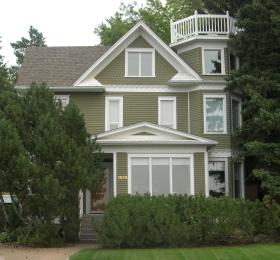Pendygrasse House
- Designated
Description of the Historic Place
The Pendygrasse House features a two and-a-half storey dwelling along St. Henry Avenue. Constructed by Harold Pendygrasse between 1909 and 1910, the home is located in the Exhibition neighbourhood and was once home to the Pendygrasse family, one of the earliest families in Saskatoon.
This historic place, located at 1919 St. Henry Avenue, was designated as a Municipal Heritage Property in 2016. The designation is limited to the building’s exterior, and does not include the addition completed in 1995.
Heritage Value
The heritage value of the Pendygrasse House lies in its association with the Pendygrasse family. Sarah Pendygrasse, arrived in Saskatoon from Ireland in 1887 with her daughter to meet her sons Harold, Sefton and Neville, who had come earlier with the Temperance Colonists. Sarah Pendygrasse received a homestead grant for the quarter section now bounded by the South Saskatchewan River, Taylor Street, Ruth Street and Lorne Avenue. Tragically, Neville had drowned in a ferry accident just weeks prior to her arrival. A log house, located on the corner of St. Henry Avenue and Isabella, was erected on the quarter section owned by the Pendygrasses. Sarah eventually returned to Ireland where she died in 1909.
Harold took over the homestead and lived in the log cabin until 1910 when he built the house at 1919 St. Henry Avenue (north of the original log house) for him and his wife, Poppy Clisby. Pendygrasse sold off much of the land of the original homestead and established a real estate business. Harold and his family lived in the home until the outbreak of the First World War. The house was rented for several years before being sold in 1918. Pendygrasse Road, located in Fairhaven, is a tribute to Sarah Pendygrasse and her family.
The heritage value of the Pendygrasse House also resides in its Queen Anne influences and unique architectural features. The large turret is one of the home’s more distinctive features, along with its widow’s walk and its fish scale shingle siding. Up until the 1950s, the house was subject to very little change. At that time, the dwelling was converted to a two-unit dwelling with main and second floor suites, along with the addition of a new stair case. The Pendygrasse House was later converted back to a single-family dwelling, and the current owners have undertaken a number of large-scale renovations to return the home to a form more true to its original. Exterior renovations to the home have included the reconstruction of the widow’s walk (1970s) after the railing had been removed in the 1950s, and correction of the roof lines (2001) that occurred as a result of the addition of the second floor suite. In 1982, the original chicken coop was demolished and a new garage was constructed at the rear of the home that compliments the home’s existing character. In 1995 a sympathetic addition was constructed to provide space for a dining room, and in 2001 a playhouse in the backyard was built as a replica of the original home.
The extent of restoration work completed by the current owners, and their regard for the character defining elements of the home, earned them an award for exterior restoration under the City’s Heritage Program in 2002 and special recognition through the Saskatchewan Architectural Heritage Society in 2001.
The Pendygrasse House continues to add visual interest and character to the surrounding neighborhood and is an excellent example of heritage conservation and restoration in Saskatoon.
Source: City of Saskatoon Built Heritage Database
Character Defining Elements
Key elements which contribute to the heritage value of this historic resource include:
- Its architecture with Queen Anne influences, evident in: its façades with the clapboard exterior and fish scale shingle siding, the turret and widow’s walk, the trim and cornices, gabled roof ends, and its form, scale and massing; and
- Those elements associated with Pendygrasse family, such as its location on the original Pendygrasse homestead and its proximity to, and views of, the South Saskatchewan River.

